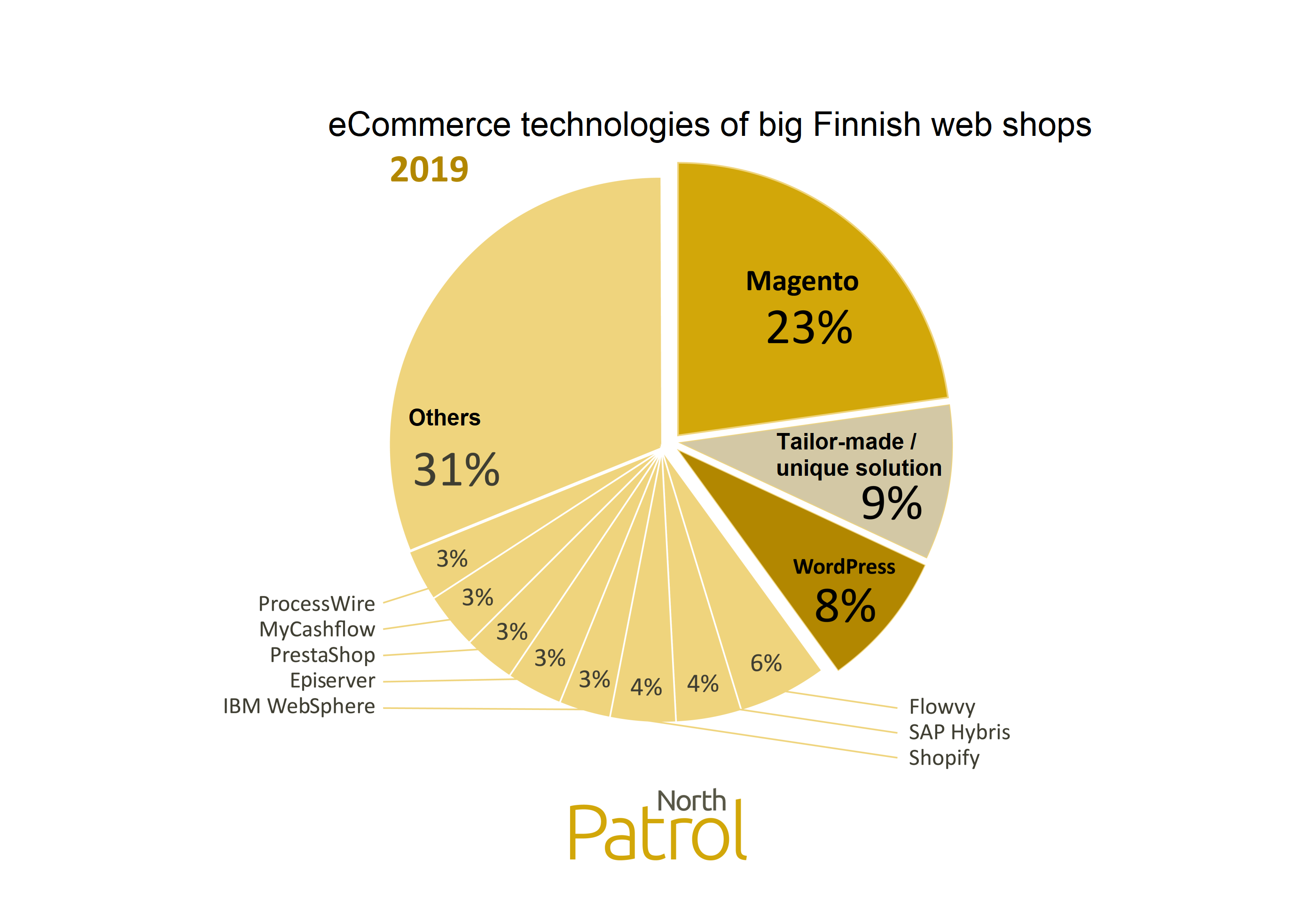We found out the eCommerce platforms the biggest companies in Finland are using. According to our review, there is a wide range of different eCommerce technologies. There are exactly 50 different platforms in use, of which 23 are used only by one company each. The combined market share of three most popular technologies is 40 percent.
North Patrol is a consulting firm specialized in the design of digital services and information systems. We shape ideas into a vision and service concept, find the best architectural and technological solutions, design a functional user experience, and compete to find the ideal partner for implementation work. We do not sell implementation projects, nor do we sell licenses; we are genuinely on the side of the customer.

The data of this review is based on a database created by North Patrol. Its results are gathered mainly by using two technology radars. The radars that are automatically analyzing web stores did not recognize all the technologies used. Therefore, the consultants of North Patrol crawled the rest manually through.
And the winner is…
The most popular eCommerce platform of companies with over 1 million euros turnover is Magento. Almost every fourth web store in this review was based on Magento. The turnover of fifteen biggest companies using Magento is over 100 million euros. In this group included are for example Suunto, Stockmann and Yliopiston apteekki. On the other hand, some 40% of companies using Magento has turnover under 10 million euros.
Silver
The second most popular solution is to build a tailor-made web store. Tailor-made web stores are often used by the biggest companies of this review. In this group included are for example K-ruoka of Kesko, Veikkaus and Verkkokauppa.com. Companies using tailor-made web stores for selling their products and services have approximately five times bigger average turnover than for example companies using Magento. It is surprising that some tailor-made web stores are found also within the smallest companies in our database.
Bronze
WooCommerce, a plugin that enables eCommerce capabilities with WordPress is the third most popular eCommerce solution. It is not necessary to always spend a lot of money to eCommerce. If the product structures and the selections are simple, why not to choose WooCommerce. On the list of WooCommerce using companies we can find for example Sinituote, Kekkilä and Juustoportti. The average turnover of companies using WooCommerce is little over 15 million euros. 65 percent of companies using WooCommerce have turnover under 10 million euros.
Other high-ranking positions
Domestic eCommerce product Flowvy takes the fourth position with six percent market share. Companies that are using it are in the B2C area. For example Veikon Kone, Helkama and Sissos are Flowvy users. The strength of Flowvy is its ability to easily connect brick-and-mortar and eCommerce sales. Except for Veikon Kone, all the companies using Flowvy had turnover under 10 million euros and the average turnover was 5,2 million euros. This is much smaller than it is with companies using WooCommerce.
The fifth place is taken by a heavy-weight eCommerce platform SAP Hybris by 4 percent market share. Hybris is popular especially among companies selling their products directly to end-customers, which includes for example Iittala, Polar and Reima. It is descriptive that none of companies using Hybris has turnover under 10 million euros. The average turnover is over 500 million euros. Many of these companies uses ERP system provided by SAP, when it is also sensible that the eCommerce is based on SAP technology.
Shopify reaches almost to the same position with SAP Hybris, as its market share is rounded to 4 percent. Almost all the companies using Shopify in this review are factories, which have a carefully selected offering available in their web stores and bigger offering is available through their resellers. For example, Fazer is selling different products in its web shop than is available through the resellers. Other Shopify users are for example Finlayson, Halti and Turo Tailor. In this review the turnover of the companies using Shopify is relatively high. The average turnover is over 300 million euros and there are no companies with less than 10 million euros turnover.
There are five eCommerce platforms with market share of 3 percent. Or to be exact there are five eCommerce platforms and one CMS. IBM WebSphere is used for example by a number of S Group web stores, Suomalainen Kirjakauppa, K-rauta and Hong Kong. Because there are massive companies using WebSphere, it is a clear number one when measured by average turnover of the companies. PrestaShop is used by for example L-Fashion Group’s Rukka Store. MyCashflow is a web store hotel which is used for example by Sampo Rosenlew for selling clothes. ProcessWire developed by Oscar Software is a web store hotel that is used for example by Finn-Savotta and Novakari. Originally Swedish Episerver CMS is used for eCommerce for example by Viking Line, Vepsäläinen and Biltema.
Other systems
Over 1 percent market share has also ePages (2,82%) by Vilkas, Viidakkostore (2,46%), Crasman Stage (1,76%), Intershop (1,76%), SalesForce Commerce Cloud (1,41%), Drupal (1,41%), Clover shop (1,41%), Joomla (1,06%) and Shuriken (1,06%).
Background of this review
We found out the eCommerce technologies of Finnish companies with over 1 million euros turnover. We selected 284 web shops selling their products and services for Finnish people. Behind these web shops there are altogether 273 different companies. The biggest number of web shops per one company was four. 10 web shops (3,5%) remained unrecognized. The turnovers used in this review are the turnovers of the chosen companies. The median turnover is 13,5 million euros per year. We are going to redo this review next year. That gives us better sight of the changes happening on the markets.
If you need assistance in evaluating what system would support you in achieving your business objectives or in comparing different products, do not hesitate to contact us.
